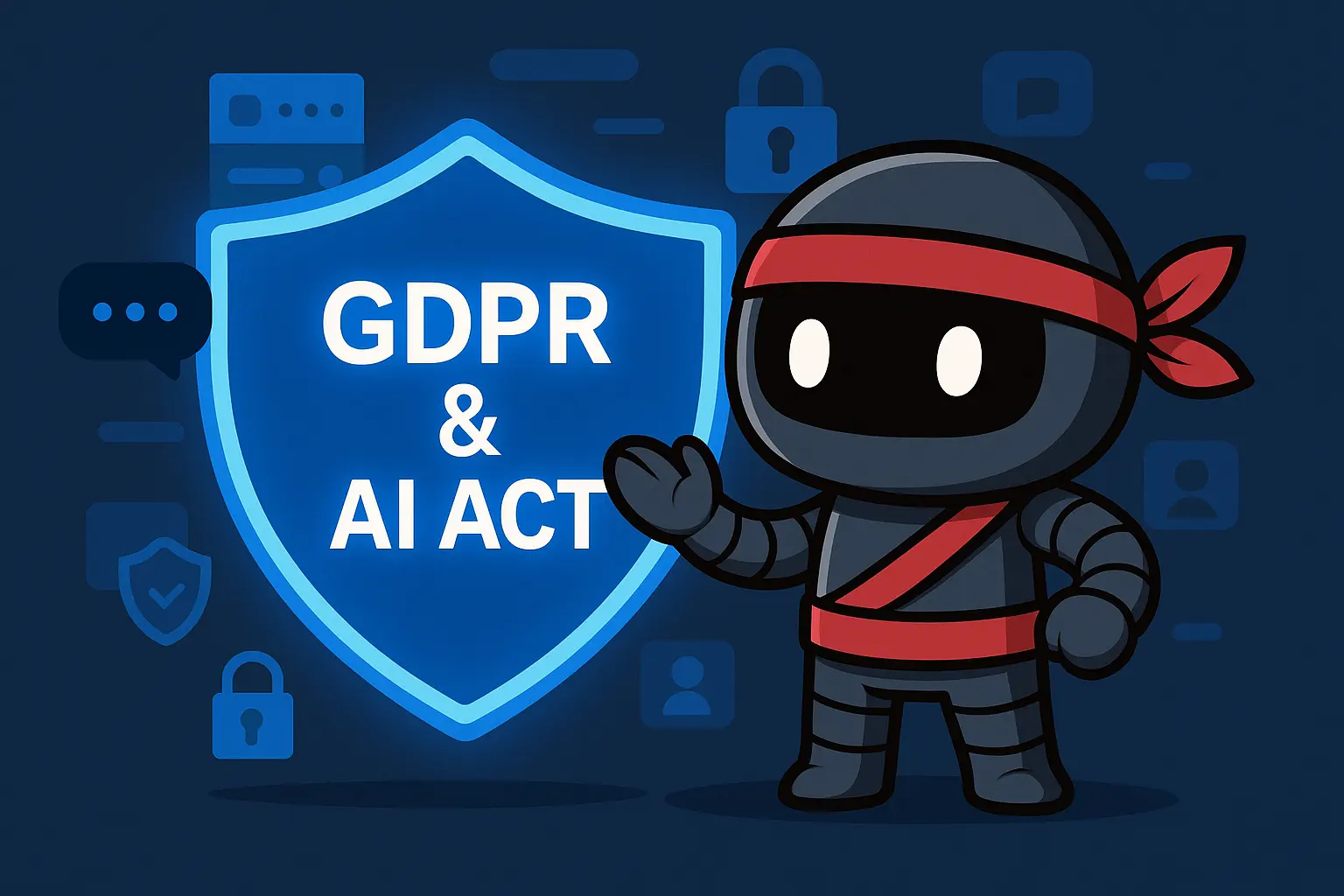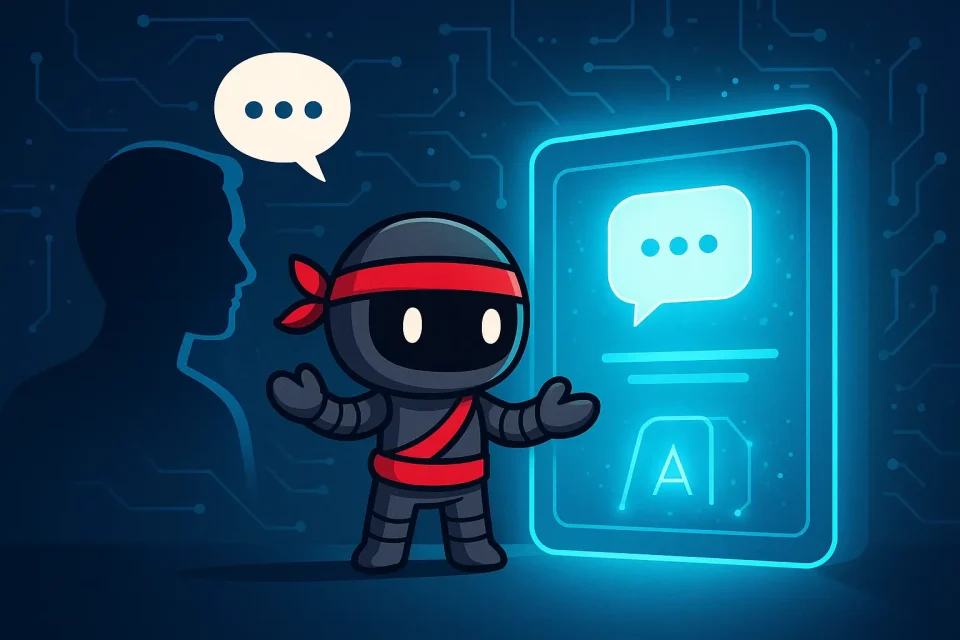AI chatbots have become the digital front door of modern business — answering questions, capturing leads, and turning browsers into buyers. But with great automation comes great responsibility.
If your business operates in the EU (or serves EU users), you’re not just building a chatbot — you’re building a regulated data-processing system. That means GDPR and, from 2025 onward, the EU AI Act both apply.
Fail to comply, and you risk more than fines. You risk your customers’ trust — and once that’s gone, no AI can rebuild it for you.
This detailed guide will walk you through how to keep your chatbot fully compliant with European privacy and AI rules — step by step.
By the end, you’ll know exactly how to design, run, and scale a chatbot that converts ethically, securely, and confidently.

Understand GDPR’s Core Principles for Chatbots
GDPR isn’t just a checklist. It’s the foundation for ethical automation — ensuring every byte of data your chatbot handles respects human rights and transparency.
When it comes to chatbot compliance, the key GDPR principles to master are:
Lawfulness, Fairness, and Transparency
Every chatbot must process personal data lawfully — and that usually means getting explicit consent.
Users must know:
- Who controls their data (you or your vendor)
- What data the chatbot collects (e.g., name, email, IP)
- Why it’s being collected
- How long it’s kept
These details should appear in plain language, not buried in legal jargon.
Even a simple chatbot greeting like:
“This AI assistant collects your name and email to help answer your questions. Learn more in our Privacy Policy.”
can meet the transparency requirement while building user trust.
Data Minimization and Purpose Limitation
A chatbot should only collect data it truly needs. If it doesn’t serve a purpose, delete it.
Examples:
- A support bot doesn’t need your birthday.
- A quote generator only needs a business name and email.
- Chat transcripts should be periodically anonymized or deleted.
Pro Tip: Build data minimization into your chatbot’s logic — not as an afterthought, but as part of its design DNA.
Step 2 — Manage Consent and Privacy Notices the Right Way
Under GDPR, consent is king — but not all consent is created equal. It must be:
- Freely given
- Specific
- Informed
- Unambiguous
Here’s how to get it right for chatbots:
✅ Use an unchecked opt-in box or “Start Chat” button clearly linked to your privacy notice.
✅ Capture the timestamp and consent text in your database (proof matters).
✅ Offer users an easy way to withdraw — for example, typing “Delete my data” or “Stop chat.”
Also, create a concise privacy notice or chatbot disclaimer that explains what happens to user data.
A good chatbot experience is like a handshake — polite, transparent, and documented.
Secure Your Chatbot: Encryption, Access Control, and Audits
GDPR demands “integrity and confidentiality.” Translation: lock everything down.
Here’s what that means for your chatbot setup:
- Use SSL/TLS encryption for all conversations.
- Encrypt data at rest and in transit.
- Restrict access to chat logs to authorized staff only.
- Conduct regular security audits and penetration tests.
Also, log who accesses chatbot data and when. That’s not just security — it’s accountability.
A GDPR-compliant chatbot treats data like currency — precious, protected, and traceable.

Respect User Rights and Handle DSARs Efficiently
Under GDPR, every user holds a bundle of rights:
🧾 Access — to see what data you store.
✏️ Rectification — to correct errors.
🗑️ Erasure — to delete data (“right to be forgotten”).
⛔ Restriction — to limit how you process it.
📦 Portability — to take it elsewhere.
🚫 Objection — to stop processing entirely.
You have one month to respond to such requests (two extra months for complex cases).
To stay compliant:
- Enable a “Request My Data” or “Delete My Info” command inside the chatbot.
- Route these requests to your data protection team automatically.
- Keep a DSAR log showing each request and your response.
Remember: GDPR compliance is 50% process, 50% proof. Documentation is your armor.
Align with the EU AI Act: Risk Classification and Transparency
While GDPR governs how you handle data, the EU AI Act governs how your AI behaves.
It’s the world’s first major AI regulation — a risk-based framework classifying AI systems as Prohibited, High-Risk, Limited-Risk, or Minimal-Risk.
Limited vs. High-Risk Chatbots
Most business chatbots (like marketing assistants or support bots) are Limited-Risk — they don’t make life-changing decisions, so the main requirement is transparency.
But if your chatbot provides medical, financial, or legal advice, it likely qualifies as High-Risk.
Those systems need:
- A risk management system
- Human oversight (the user must reach a human easily)
- Quality and bias control
- A conformity assessment before going live in the EU
Misclassify your chatbot, and you’re in deep water — the AI Act fines can hit 6% of global turnover.
Transparency Requirements
For Limited-Risk bots:
- Clearly state users are chatting with AI (“I’m an AI assistant — not a human”).
- Label any AI-generated content.
- Provide an option to reach a human when requested.
From February 2025, this will be a legal obligation, not a best practice.
Transparency isn’t just compliance — it’s empathy coded in design.
Conduct DPIAs and Maintain Accountability
A Data Protection Impact Assessment (DPIA) helps identify privacy risks before they become violations.
You should run one if your chatbot:
- Processes sensitive or large-scale personal data
- Uses profiling or machine learning to tailor responses
- Integrates with CRM or analytics tools that store personal identifiers
How to do it:
- Map every data flow (collection, processing, storage, deletion).
- Identify high-risk points (e.g., user authentication, chat transcripts).
- Implement mitigation (e.g., pseudonymization, data minimization).
- Record findings and decisions.
Keep DPIAs updated whenever the bot changes — new features = new risks.
Also, document everything: security audits, staff training, third-party vendors, and retention policies.
Accountability isn’t about fear of fines — it’s about owning your data story.
Common Pitfalls and How to Avoid Them
Even good teams stumble here. Avoid these classic traps:
🚫 Collecting too much data.
→ Solution: Ask only what’s essential. Automate deletion.
🚫 Assuming consent = conversation.
→ Solution: Get explicit opt-in before chat starts.
🚫 Forgetting transparency labels.
→ Solution: Display “AI Assistant” at the chat window’s start.
🚫 No DSAR process.
→ Solution: Integrate data requests directly in the chatbot.
🚫 Skipping DPIAs or security audits.
→ Solution: Review quarterly. Document outcomes.
🚫 Assuming all bots are “Limited-Risk.”
→ Solution: Check classification yearly — new features can raise your risk level.
Compliance isn’t static. It’s an ongoing discipline — like cybersecurity, it evolves as your tech does.
Best Practices for GDPR & AI Act Harmony
To align both frameworks smoothly:
- Privacy by Design: Embed privacy controls at development, not post-launch.
- Audit Trails: Log all access, training data, and model updates.
- Vendor Management: Choose AI providers who are GDPR- and AI Act-ready.
- User Empowerment: Let users delete or export data from the chat interface.
- Human Oversight: Always offer a “Talk to a human” option.
- Continuous Training: Educate developers and staff on compliance obligations.
A chatbot that’s compliant is not just safer — it’s marketable. EU consumers are becoming privacy-conscious; they’ll reward brands that respect their data.
How an SME Uses NinjaiBot to Stay Fully Compliant
Meet LunaCraft, a small European e-commerce brand selling artisanal products.
Their challenge: scale customer interactions without tripping over GDPR or the AI Act.
They deployed NinjaiBot, designed by AlgeniaLab Srl — an AI chatbot platform that’s compliant by design.
Here’s how LunaCraft built trust and performance:
- Smart Consent Flow
- Before chat starts, users see: “This chatbot collects your name and email to assist you. You can withdraw consent anytime.”
- NinjaiBot logs this opt-in securely.
- Minimal Data Mode
- The bot collects only essentials — no IP tracking, no hidden identifiers.
- Chat logs auto-delete after 30 days.
- Transparent Identity
- Chat window reads “AI Chatbot – Not a Human.”
- Users can type “human” anytime for escalation.
- GDPR & AI Act Documentation
- NinjaiBot’s dashboard stores DPIAs, consent logs, and audit reports.
- The company’s DPO can export compliance evidence in one click.
- Continuous Improvement
- The system runs quarterly compliance checks against EU guidelines.
- Updates automatically apply new legal requirements.
The result?
✅ 100% GDPR readiness.
✅ Instant AI Act transparency.
✅ Zero user complaints.
✅ 38% more qualified leads.
LunaCraft didn’t just meet regulations — they turned compliance into a competitive advantage.
Build Trust and Compliance by Design
Let’s be clear — compliance isn’t bureaucracy; it’s brand armor.
A compliant chatbot doesn’t just avoid penalties — it earns loyalty.
When your users see transparency, consent, and security at every step, they don’t hesitate to engage.
They trust your chatbot.
And trust is the real ROI of compliance.
In a world moving fast toward regulated AI, the smartest move isn’t to wait — it’s to lead.
Design compliance now, and you’ll be future-proof when the AI Act lands in full force.
FAQ — GDPR & EU AI Act Compliance for Chatbots
Do I always need consent for a chatbot?
If your chatbot processes personal data, yes — you must obtain explicit opt-in consent and allow users to withdraw it easily at any time.
Are most chatbots high-risk under the EU AI Act?
No. Most business chatbots are classified as Limited-Risk. Only chatbots that influence legal, financial, or health outcomes may be considered High-Risk.
What must a chatbot disclose under the AI Act?
Your chatbot must clearly inform users that they are interacting with an AI system, label AI-generated content where relevant, and provide a way to reach a human agent.
How fast must we respond to Data Subject Access Requests (DSARs)?
You must respond within one month. Extensions (up to two additional months) are allowed only for complex requests.
What compliance records should we maintain?
Keep consent logs, your Article 30 Record of Processing Activities (ROPA), your DPIA, training logs, vendor DPAs, and model/version change logs.
Does a chatbot need a Data Protection Impact Assessment (DPIA)?
A DPIA is required if your chatbot processes sensitive data, performs large-scale profiling, or could create high risk for individuals. Even when not mandatory, it’s considered best practice.
Can I store full chatbot transcripts under GDPR?
You can store them only if strictly necessary and justified. Define a retention period, minimize personal data, and delete or anonymize transcripts when no longer needed.
How do I classify my chatbot under the EU AI Act?
Most chatbots are Limited-Risk. If your chatbot influences decisions in healthcare, finance, or legal settings, it may be High-Risk and require conformity assessment and tighter controls.
What are the penalties for non-compliance?
GDPR fines can reach €20M or 4% of global turnover. Under the EU AI Act, serious violations can reach up to 6% of global turnover.
If you’re looking for a compliant chatbot,
NinjaiBot is the perfect solution — trained on your brand’s voice, optimized for conversion, and engineered with GDPR and EU AI Act compliance built in.


